| Author |
Message |
    
Stephen Thomas
Unregistered guest
| | Posted on Thursday, August 25, 2005 - 12:54 pm: | 





|
Visitors to London might like to view the location of the strange meeting between Cutbush and W.K. as described in the Sun articles, especially as it is close to the must see Camden Market held at weekends. The whole area is much the same as it was in JTR's time.
AT 10.30 ON A MARCH NIGHT IN 1891 A MAN WAS SEEN LURKING IN THE VICINITY OF A RUINED BUILDING IN THE NORTH OF LONDON. THIS IS CLOSE TO A STREET PAST WHICH THE TRAIN RUNS AND WK GOT OUT AT THIS POINT WITH HIS SWEETHEART. AS THEY WALKED THE FIGURE OF A THIN, TALL YOUNG MAN APPROACHED THEM IN THE DARK.
Given the street names mentioned later, this can only refer to Camden Road Station which was built in 1850 and is still in use on the overground North London Line. At the time it was called Camden Town Station, the name change occurring when the nearby underground station opened. Close by is Agar Grove, formerly St. Paul's Road where the Sickert associated Camden Town Murder occurred. It would seem that W.K. and his girlfriend came out of the station and walked down Camden Street and met Cutbush between Georgiana Street and Pratt Street. Nowadays there is a gloomy park here which I always suspected had once been a cemetary. Sure enough the 1862 map which can be viewed on the Net on the MOTCO site shows it as 'Burial ground for St. Martin's in the Fields (closed)' Perhaps the ruined building was part of this disused cemetary. Pratt Street, incidentally, can be seen in Hitchcock's second 'Man Who Knew Too Much'. When James Stewart visits Camden Town he is shown walking along Pratt Street towards Royal College Street on which can be seen a house with an unusual arched frontage. The French poets Rimbaud and Verlaine lived there in 1873 and there Rimbaud wrote 'A Season in Hell'. At the bottom of Royal College Street lived more recently Anthony Hardy, the 'Camden Ripper'. A lady I happen to know was invited back to his home but luckily declined the offer. Camden Street leads down to Mornington Crescent where Sickert lived and painted 'Jack the Ripper's Bedroom'.
WE FOLLOWED HIM UP CAMDEN STREET, PAST GEORGIANA STREET, ACROSS CAMDEN ROAD, AND BY THE SIDE OF WINKWORTH'S WINE PLACE BY BAYHAM WHARF, WHERE I WENT DOWN, BUT HE DID NOT AND I MISSED HIM COMPLETELY.
The 'wine place' presumably stood on the north east corner of the junction of Camden Street and Camden Road where there is now a Sainsbury's supermarket. The wharf which can be seen on the 1862 map is now covered by some very modern houses with curved metal frontage. The canal remains the same and the railway still passes overhead. The name of the wharf would have come from it's proximity to Bayham Street where Charles Dickens lived as a teenager. The house he lived in has been demolished but lots of similar houses still remain on the south side of the street.
SHOW ME THE WAY TO THE FIELDS WHERE I SHALL BE SAFE.
The 'Fields' refers to Parliament Hill Fields which is the name of the southern part of Hampstead Heath and not to some sort of farming area as one might imagine. Ripper author Colin Wilson famously slept on the Heath to save money while writing his first book 'The Outsider'. To get there, Cutbush would have had to have travelled through Kentish Town which is the area directly north of Camden Town. Now I don't have much time for Patricia Cornwell's book but she did come up with an interesting possible Ripper link to Kentish Town that I have not seen elsewhere. She says that on the day after the 'Double Event' a Mr. Chinn who was the landlord of a pub in Kentish Town called The Nelson Tavern found a newspaper package behind the pub which contained a pair of bloodstained trousers. Ms. Cornwell speculates that the quite large newspaper package carried by Liz Stride's companion (and probable murderer) contained a change of clothing. Could Liz's companion have been Cutbush (the witnesses describe someone of his age and type) and could he have discarded his bloody clothes on his way to 'the fields'?
P.S. I would be most grateful if anyone can tell me the location of The Nelson Tavern which may still exist under a different name. |
    
AP Wolf
Assistant Commissioner
Username: Apwolf
Post Number: 2430
Registered: 2-2003
| | Posted on Thursday, August 25, 2005 - 4:29 pm: | 





|
I enjoyed that little romp through history, Stephen, and I'd like to see you coming around here a bit more.
It was my intention to trace back the original gegraphical locations mentioned in the Sun reports but I neither have the time or expertise.
You certainly have.
I'll see if I can't run down the Nelson Tavern for you.
Many thanks for the tour. |
    
AP Wolf
Assistant Commissioner
Username: Apwolf
Post Number: 2431
Registered: 2-2003
| | Posted on Thursday, August 25, 2005 - 4:38 pm: | 





|
The Nelson Tavern was in Victoria Road, Kentish Town.
The full circumstances of the discovery of the 'dark' trousers is reported in The Times of October 2nd 1888. |
    
Robert Charles Linford
Assistant Commissioner
Username: Robert
Post Number: 4867
Registered: 3-2003
| | Posted on Thursday, August 25, 2005 - 5:36 pm: | 





|
Thank you, Stephen. A very interesting post indeed.
Robert |
    
AP Wolf
Assistant Commissioner
Username: Apwolf
Post Number: 2432
Registered: 2-2003
| | Posted on Thursday, August 25, 2005 - 5:42 pm: | 





|
Victoria Road is now called Castlehaven Road and the only pub I can locate is at number 2, the Hawley Arms.
I would suspect that this once was the Nelson Tavern as it has much to do with a traditional market.
'Camden Town: Take the Camden High Street exit and turn right out of the tube. Carry on up the High Street past most of Camden Lock Market until you reach the railway bridge crossing the road. Turn right into Castlehaven Road and the pub is just there.'
|
    
Natalie Severn
Assistant Commissioner
Username: Severn
Post Number: 2356
Registered: 11-2003
| | Posted on Thursday, August 25, 2005 - 5:51 pm: | 





|
Yes,I know Camden Town quite well but hadnt located these particular spots Stephen.
They used to have a brilliant bookshop there up until a few years back called Compendium Books-I used to go there often and still miss it!
Many Thanks Stephen
Natalie |
    
Robert Charles Linford
Assistant Commissioner
Username: Robert
Post Number: 4868
Registered: 3-2003
| | Posted on Thursday, August 25, 2005 - 6:04 pm: | 





|
Stephen, the Nelson was at number 49, or was in 1881 anyhow.
Robert |
    
Nathanmerry
Unregistered guest
| | Posted on Friday, August 26, 2005 - 6:43 am: | 





|
Stephen Thomas & Ap Wolf
I live in Kentish Town & Go Down Castle Haven Rd on a regular basis, there was a pub on the corner of what used to be clarence way near the bottom of the road but it closed down years ago, its now a Thai Resaurant. hope this is of any use.
Nathan |
    
Stephen Thomas
Unregistered guest
| | Posted on Sunday, September 04, 2005 - 7:05 am: | 





|
AP, Robert, Natalie, Nathan
Many thanks for your assistance and kind comments. In 1888 Castlehaven Road was two roads, Grange Road at the Camden Town end and Victoria Road in Kentish Town above Hawley Road, so if the Nelson Tavern was on Victoria Road it cannot be now The Hawley Arms. This is a lovely Victorian pub but is situated on what was then Grange Road. The building Nathan describes seems to fit the bill. It even has the wooden gates that JTR seemed to like at the back. It is situated on the south east corner of the Clarence Way/Castlehaven Road junction and it's current address is 41 Castlehaven Road which is close to the address that Robert kindly supplied. However it may also have been the Victory Tavern which I found out about on the Charles Booth Poverty Map site. Here's what one of Booth's researchers writes about Clarence Road (now Clarence Way):
WALK WITH INSPECTOR TOMKIN DISTRICT 19 (KENTISH TOWN) 2 NOVEMBER 1898. PASSED THE VICTORY FULLY LICENCED HOUSE. BEEN RATHER ROUGH. RECENTLY CHANGED HANDS, THE NEW LANDLORD BEING A MAN WELL KNOWN IN THE DIVISION. A MURDER IN THIS HOUSE (BARMAID) 12 YEARS AGO.
Any chance of digging that murder out AP? You seem to be able to work wonders on that front. There was also another case (unsolved) at the time of a woman being murdered in Kentish Town which is mentioned in one of the press reports on this site.
At any time the discovery of clothing wrapped in bloodstained newspaper would be suspicious. The day after a bloody double murder I would say it is highly significant. Imagine if the package was found in, say, a doorway in Goulston Street. And if you look at map you will see that the distance from the top of College Street where the WK/Cutbush meeting took place, along Hawley Road to Castlehaven Road, where the Nelson Tavern is or was located, happens to be just a few hundred yards.
Thanks again.
|
    
Stephen Thomas
Unregistered guest
| | Posted on Tuesday, September 27, 2005 - 8:39 am: | 





|
This is the Nelson Tavern.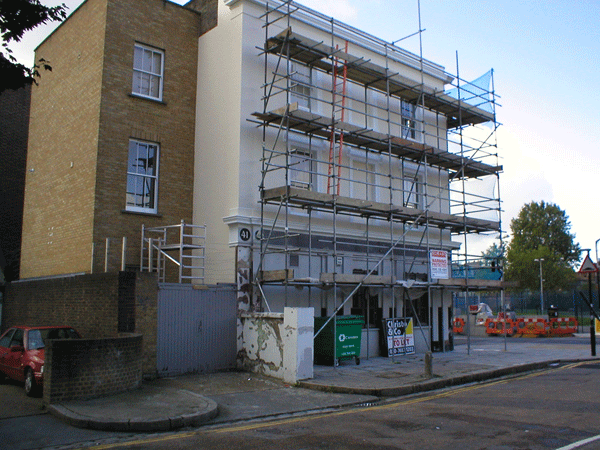 |
    
Robert Charles Linford
Assistant Commissioner
Username: Robert
Post Number: 5066
Registered: 3-2003
| | Posted on Tuesday, September 27, 2005 - 10:34 am: | 





|
Thanks very much for that, Stephen.
MAY 24th 1890
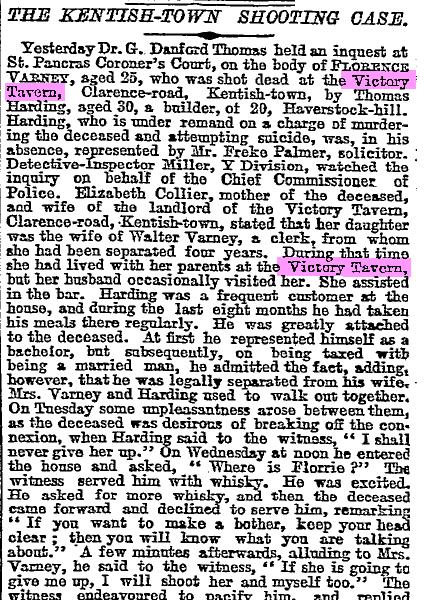
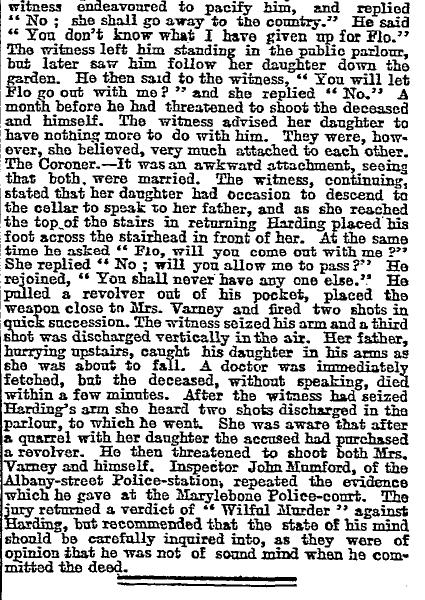
Robert |
    
AP Wolf
Assistant Commissioner
Username: Apwolf
Post Number: 2572
Registered: 2-2003
| | Posted on Tuesday, September 27, 2005 - 1:20 pm: | 





|
Well done, Robert, and my apologies to Stephen as I have only just come across his very interesting posts.
I'm sure I've come across several 'Kentish-Town' murders in my travels and must see if I can find them again. |
    
Stephen Thomas
Unregistered guest
| | Posted on Tuesday, September 27, 2005 - 8:55 am: | 





|
Here's a close-up of the wooden gates behind which the dark trousers wrapped in a bloodstained newspaper parcel were found the day after the 'Double Event'.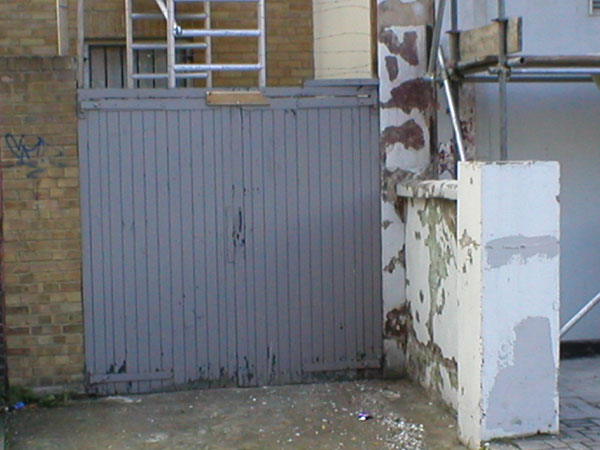 |
    
Stephen Thomas
Unregistered guest
| | Posted on Tuesday, September 27, 2005 - 10:19 am: | 





|
Lastly here's what used to be called the Victory Tavern nearby on Clarence Road/Way where a barmaid was murdered around 1886. Any information on this and another murder of a woman in Kentish Town just prior to the Whitechapel murders (in a Dairy I believe) would be most welcome. This pub was described in 1898 as being 'rather rough'. The current landlord has decided to improve the rather fine mock Tudor building by painting on 'go faster' flames and keeping the lower windows permanently boarded up. Plus ca change, plus c'est la meme chose. That's the train on it's way to Camden Road Station above the pub by the way. Lastly while I'm here can anyone supply the address/addresses of the Cutbushes in Highgate so I can maybe check them out. Thanks.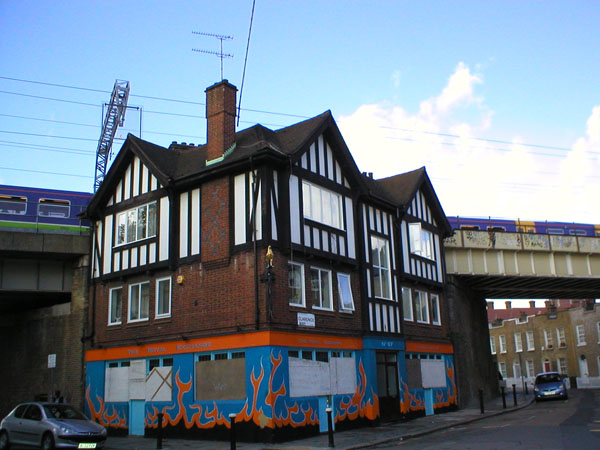 |
    
AP Wolf
Assistant Commissioner
Username: Apwolf
Post Number: 2576
Registered: 2-2003
| | Posted on Tuesday, September 27, 2005 - 5:55 pm: | 





|
Stephen
Thanks for that again.
The Kentish Town barmaid you refer to was Charlotta Clifford who was said to have been murdered by a surgeon and midwife during an aborted abortion.
That was January 16th 1886.
Still looking for more detail, but I think this is the murder you are looking for.
I am still looking through the 1888 reports. |
    
Robert Charles Linford
Assistant Commissioner
Username: Robert
Post Number: 5071
Registered: 3-2003
| | Posted on Tuesday, September 27, 2005 - 5:57 pm: | 





|
Stephen, the rose-sniffers lived at 1 West Hill, St Pancras. There was a pub called the Fox and Crown five doors along.
Robert |
    
AP Wolf
Assistant Commissioner
Username: Apwolf
Post Number: 2577
Registered: 2-2003
| | Posted on Tuesday, September 27, 2005 - 6:06 pm: | 





|
Just to add to Robert's rose sniffers:
At Highgate a nursery which had existed in 1804 became that of William Cutbush; in 1881 the firm had 4 a. at Highgate, where it remained until 1918, 20 a. at Barnet, and 7 a. at Finchley
From: 'Hornsey, including Highgate: Economic history', A History of the County of Middlesex: Volume 6: Friern Barnet, Finchley, Hornsey with Highgate (1980), pp. 149-57. URL: http://www.british-history.ac.uk/report.asp?compid=22523. Date accessed: 27 September 2005.
Other nurseries were smaller and short-lived, except those of the Clementses and of James Cutbush, who leased 6 a. of Bibbesworth land from 1864. By 1909 William Cutbush & Son, the Highgate firm, had Plant Farm, which survived in 1938, south of East End Road, next to the St. Marylebone cemetery.
From: 'Finchley: Economic history', A History of the County of Middlesex: Volume 6: Friern Barnet, Finchley, Hornsey with Highgate (1980), pp. 64-73. URL: http://www.british-history.ac.uk/report.asp?compid=22504. Date accessed: 27 September 2005 |
    
Stephen Thomas
Unregistered guest
| | Posted on Thursday, September 29, 2005 - 9:47 am: | 





|
Robert
Thanks for the newspaper cutting. I've no idea how you do that but I'm very impressed and grateful for your response. A very sad case, tragic even, but the 'I can't have you so nobody else will and I'm prepared to die as well' motive has been common in all societies through the ages. I hope the poor man (sorry AP) wasn't hanged but I suppose he was. As you will know, an almost identical case happened a week or so ago in the poshest department store in London and made front page news when a store security guard shot and killed his ex-girlfriend working at her counter and then shot himself dead.
Robert, AP
A strange mix up of murders and dates here. I suppose the policeman was referring to the murder Robert found 8 years before, but confused it with the other barmaid murder, that AP kindly found, that happened 12 years before in 1886.
Dear AP
Good news! With the information you supplied I have managed to locate the site of William Cutbush's nursery and guess where it used to be? It was right on the edge of Parliament Hill Fields on the Highgate Road side and the site is now part of the fields, mostly tennis courts, and would be about 4 acres. The address Robert supplied i.e. 1 West Hill, St. Pancras would have been on what is now called Highgate West Hill but numbers 1-4 have now been replaced by what looks like an Edwardian appartment block. Across the road however is a large old house with those large wooden double gates which may have been Number 1 in those days. Either way the house would have been a short distance from the nursery. So when Thomas asked WK to show him the way to the fields he didn't want to get to the fields as such but back to possibly sympathetic relatives.
|
    
Stephen Thomas
Unregistered guest
| | Posted on Saturday, October 01, 2005 - 9:44 am: | 





|
AP, Robert, Natalie
Just for you for all your hard work. First time on the Casebook. First time anywhere. Here is the Berner Street Panorama 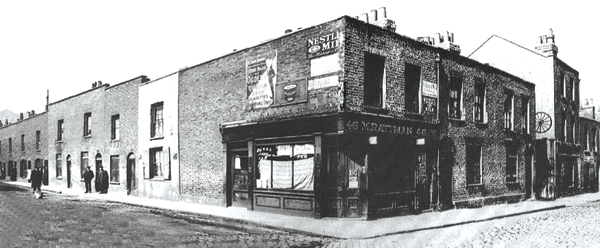 |
    
Stephen Thomas
Unregistered guest
| | Posted on Saturday, October 01, 2005 - 9:44 am: | 





|
AP, Robert, Natalie
Just for you for all your hard work. First time on the Casebook. First time anywhere. Here is the Berner Street Panorama |
    
Robert Charles Linford
Assistant Commissioner
Username: Robert
Post Number: 5097
Registered: 3-2003
| | Posted on Sunday, October 02, 2005 - 5:41 am: | 





|
Thanks for all that, Stephen. So far there hasn't seemed to be much connection between Thomas and the horticultural Cutbushes. But then, I haven't really been concentrating on the rose-sniffers. In fact, it's more like they've been concentrating on me, apparently following me around wherever I go. However, I must put on my gardening gloves, grasp the nettle, and try to find out more about them!
Robert |
    
AP Wolf
Assistant Commissioner
Username: Apwolf
Post Number: 2611
Registered: 2-2003
| | Posted on Sunday, October 02, 2005 - 2:02 pm: | 





|
Yes, Stephen, brilliant work.
My impression has always been that Thomas would have been farmed out to his male relatives on account of the sudden departure of the complete and utter bastard who passed as his father.
I think you follow a good path here. |
    
Natalie Severn
Assistant Commissioner
Username: Severn
Post Number: 2483
Registered: 11-2003
| | Posted on Sunday, October 02, 2005 - 4:56 pm: | 





|
I echo AP and Robert here-brilliant Stephen!
I adore that photo of Berner Street too-gives you such a feel for the place as it was around then.
Many Thanks
Natalie |
    
Stephen Thomas
Unregistered guest
| | Posted on Sunday, October 02, 2005 - 5:39 pm: | 





|
Robert
I share your antipathy to all things horticultural but I do think this may be a fruitful (sorry) line of investigation. The address you gave i.e. 1 West hill, St.Pancras seemed a little strange and archaic, or rather the St.Pancras bit did as that's sort of a medieval name for the area. When I looked at the 1862 map I saw there was a nursery clearly marked at the edge of Parliament Hill Fields close to what would be No.1 Highgate West Hill so I assumed that this was the Cutbush nursery though there was no Fox and Crown pub as you stated or any other pub five doors away. Since then I have discovered that the actual address for the nursery was 45 West Hill just, as you said, five doors away from where the Fox and Crown stood at No.40. It was in the grounds of an old demolished tavern and has an impressive gatehouse entrance that I've long admired. Numbers 41 to 45 have now been replaced by an area of large appartment blocks (not modern) all with the address 41 and accessed through said gatehouse. In Victorian times the house numbers crossed the road as it were and went back down the hill, 46 being opposite 45, 47 opposite 44 etc. Today the numbers on the other side are all different. Now here's the good bit, and I quote from a walking tour guide for Highgate. 'The nursery gardening firm of William Cutbush had a shop at No.80 (Formerly No.47) until 1918'. This house is definitely there today. It is a lovely 18th century house painted yellow with no front garden. The front door opens straight on to the pavement and it has the small bay window with lots of panes that shops had then. I took photos today but I'm not able to post them at the moment. Interestingly the house has a garret room with a window in the roof of the kind in which Cutbush lived according to the Sun reports.
So back to 1891 and the sighting of Thomas Cutbush in Camden Town. Now I do realise that the story may be journalistic hokum but it just might be true so what is supposed to have happened? It's a Saturday night in March and WK and his girlfriend are 'walking out'. At 10.30 they meet Cutbush who rants on about women all cut open and �500 rewards and whatnot and indicates that he is heading due north to 'the fields' which just happen to be at the bottom of Highgate West Hill where he just happens to have relatives living at the top. At 10.50 he goes off heading north. At midnight he arrives at what the Sun calls 'his house'. He has a bath and changes into his own clothes and his relatives are surprised when he goes out again all night, only returning for Sunday lunch the next day. After lunch he goes to sleep and a relative removes a knife from his trouser pocket and hides it. Given that Cutbush is supposed to be a lunatic who has just made a dramatic escape from an asylum and is carrying a six inch knife, his relatives seem remarkably relaxed about the situation, apparently not even bothering to call the police who only appear later to arrest Thomas having heard that he had 'returned home'.
A very strange story which may or not be true but what is certain is that the house of William Cutbush in Highgate is an hour's walk from where Thomas was last seen in Camden Town. |
    
Robert Charles Linford
Assistant Commissioner
Username: Robert
Post Number: 5103
Registered: 3-2003
| | Posted on Monday, October 03, 2005 - 9:43 am: | 





|
Hi Stephen
I'm looking forward to seeing the photos!
Yes, the West Hill business is confusing, with houses that have names instead of numbers.
The nursery Cutbushes have not so far been mentioned in the wills, though we do know that Supt Charles's father was a seedsman.
Also, was it you who mentioned that Thomas might have given the name "James" on his arrest because of a link to the late nurseryman?
All interesting stuff, anyway.
Robert |
    
Robert Charles Linford
Assistant Commissioner
Username: Robert
Post Number: 5110
Registered: 3-2003
| | Posted on Tuesday, October 04, 2005 - 4:55 pm: | 





|
I've tracked James back through the censuses. I notice that one of his daughters is listed epileptic, which might explain James's fatal fit.
Robert |
    
Stephen Thomas
Unregistered guest
| | Posted on Friday, October 07, 2005 - 11:21 am: | 





|
This gatehouse is what was almost certainly the entrance to the Cutbush nursery in Highgate. It's just across the road from the shop and it's unusual in that it has two entrances. I suppose a Victorian ordinance survey would show what was originally behind it. Yes, AP, it just might be that this is where Thomas spent the missing two and a bit years and a map may show that this building and the roads behind may correspond with the Sun's description of the house Thomas was living in at the time. 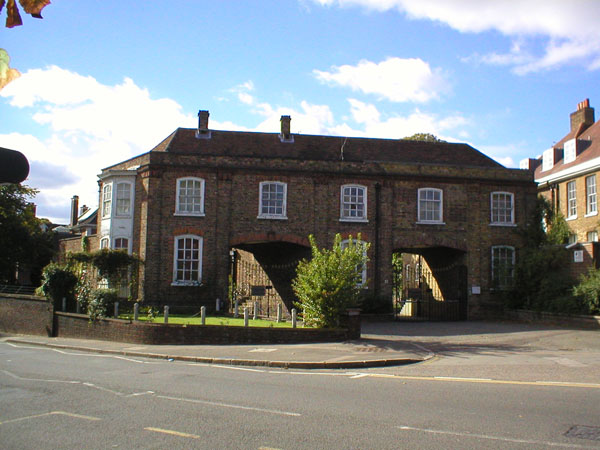 |
    
Stephen Thomas
Unregistered guest
| | Posted on Friday, October 07, 2005 - 10:15 am: | 





|
A full on view of the Cutbush shop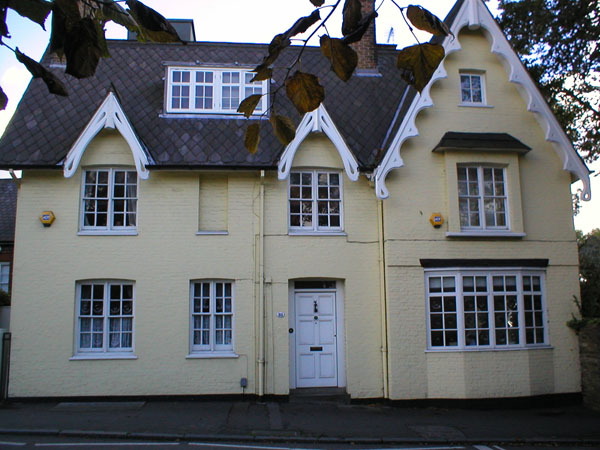 |
    
Stephen Thomas
Unregistered guest
| | Posted on Friday, October 07, 2005 - 10:00 am: | 





|
Here is the 'shop' of William Cutbush and Son in Highgate, London N6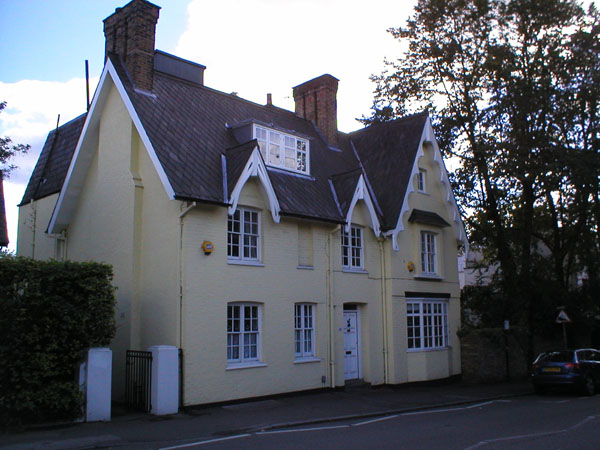 |
    
Stephen Thomas
Unregistered guest
| | Posted on Sunday, October 16, 2005 - 8:21 am: | 





|
Sorry, people. That gatehouse is absolutely nothing to do with the Cutbushes. It's actually the entrance to the second largest private estate in London, the first being Buckingham Palace. The nursery at No. 45 was just across the road next door to the Cutbush house at No. 47, that is to the left of the house in the photo.
From 'The History of the County of Middlesex Vol. 6'
'The White Hart at the top of West Hill was leased with 5 acres to William Bowstread in 1780. Bowstread had a nursery there in 1804, the inn having closed, and William Cutbush by 1822'
'At the top of of Highgate West Hill No. 79 (formerly numbers 45 and 46) occupies a site mentioned in 1493 where the White Hart stood by 1664, and is a conversion from 3 cottages. The nursery gardening firm of William Cutbush had a shop at No.80 (formerly No.47) until 1918'. |
    
Natalie Severn
Assistant Commissioner
Username: Severn
Post Number: 2501
Registered: 11-2003
| | Posted on Tuesday, October 18, 2005 - 5:15 pm: | 





|
Lovely photographs above.
Did the first in this series belong to the Cutbushes do you know or are you implying you made a mistake here?
If it did it may well have served as a place to contain him -with a little help from some men in white coats!
Interesting that the shop that belonged to the Cutbush brothers in Hihghgate has similar architectural features to the Whitechapel Bell Foundry shop and house,also associated with the Cutbush family.The front door is almost the same and in both cases leads straight onto the street and the windows and panes of glass are similar too if I remember rightly.
There is a pretty big Nursery still in Highgate High Street -doubt any relatives of the Cutbushes are involved in running it though-but interesting that the tradition continues.
Thanks for all these great pictures Stephen!
Natalie |
    
AP Wolf
Assistant Commissioner
Username: Apwolf
Post Number: 2685
Registered: 2-2003
| | Posted on Tuesday, October 18, 2005 - 5:27 pm: | 





|
Yes, Stephen, I do like your work very much indeed, and still feel you travel up the right garden path.
Natalie, I do know what you mean about the Whitechapel Foundry shop and this house.
They have echoes. |
    
Robert Charles Linford
Assistant Commissioner
Username: Robert
Post Number: 5169
Registered: 3-2003
| | Posted on Tuesday, October 18, 2005 - 6:38 pm: | 





|
Lovely pictures, Stephen. Thank you for posting them.
Robert |
    
Stephen Thomas
Unregistered guest
| | Posted on Wednesday, October 19, 2005 - 5:24 pm: | 





|
Thanks Natalie, AP, and Robert.
Yes, Natalie, I made a big mistake regarding that gatehouse which as I said is nothing to do with the Cutbushes though it is just across the road from the lovely Cutbush house and would have constituted the main view from Thomas's garret room (if that ever was his room of course) while he was doing his special, er, sketches and shoving his clothes up the chimney. An Ordinance Survey map from nearer the time may indicate a similarity between this house and 'Thomas's house' as described in the Sun reports. I mean the mews behind the house as described etc. Was this the case at his supposed South London house with his hysterical aunts? The Sun refers to 'a' road behind the house as opposed to what would normally be called 'the' road. There is to the right of the house an area now being used as a car park which may in the LVP have been the entrance to a mews which may have led to the nursery next door to this house. Can anyone show that Thomas's house as described in the Sun reports corresponds with the Kennington house where he was supposed to be living? In fact can anyone tell me how Thomas was arrested for his 'jobbing' exploits? It sounds like a stitch up to me. Who witnessed it? Who apprehended him at the scene of the crime? There seems to be no record of this. There seems to have been no blood spilled. The young lady involved seems to have only had her skirt cut a bit and didn't see who did it anyway. Please correct me if I'm wrong. And on what date did this dreadful attack occur? |
    
Natalie Severn
Assistant Commissioner
Username: Severn
Post Number: 2509
Registered: 11-2003
| | Posted on Thursday, October 20, 2005 - 6:44 pm: | 





|
Interesting questions Stephen but I dont know the answers to them.However I have become more and more curious about these two "jobbing" acts that resulted in Thomas Cutbush being put in Broadmoor for life,particularly as the other "jobber", Collicut, active concurrently with Cutbush,got off very lightly by comparison.
As for the details of the roads and houses you would need the ordnance survey maps of 1894 or thereabouts for both Kennington and Highgate to find out.There are ones for Highbury and Islington for 1871/94/1914,for Kentish Town 1870/1913 for Highgate 1894 and 1913 and for Kennington and Walworth 1871/1894/1914.They can be obtained from www.alangodfreymaps.co.uk and cost about �3 each.Maybe soon I will send off for some!
Best
Natalie |
    
Stephen Thomas
Unregistered guest
| | Posted on Thursday, October 27, 2005 - 5:31 pm: | 





|
Hi, Natalie,
Many thanks for that. The ordinance survey maps are very reasonably priced, less than 3 pounds including postage, which surprised me given how good I know they are. However, for the time being, I have found that the house of Thomas Cutbush as described in the Sun articles is almost certainly the house in Kennington.
From the Sun 17 Feb. 1894:
THE HOUSE IS SEPARATED BY A WALL FROM A MEWS, KEPT OPEN DURING THE NIGHT FOR THE CONVENIENCE OF CARMEN. THE ENTRANCE TO THE MEWS IS FROM A STREET RUNNING BEHIND THE HOUSES....WHEN HE CAME HOME EARLY IN THE MORNIG HE CLIMBED THE GARDEN WALL AND ENTERED THE HOUSE BY THE BACK WINDOW AND BY THE SAME MEANS HE LEFT IT WHEN AN ENDEAVOUR WAS MADE TO SECURE HIM AS A LUNATIC.
Booth's Poverty Map researcher 1898:
ALBERTA STREET, LATE ALBERT STREET. TWO AND A HALF STOREY, GOOD BACKS. ALL TO COME DOWN WHEN LEASES FALL IN. THESE HOUSES ARE TWO ROOMS THICK. THE NEW HOUSES ARE THREE ROOMS THICK. PINK AS MAP. BACK OF ALBERTA ROAD IS CANTERBURY MEWS: HAS(?) YARD. ONLY ONE L.G.O. FOREMAN LIVING OVER. PINK IF MARKED.
Natalie, if you go on to the MOTCO UK site you will see it all. Call up the 1862 London map and click on Albert Street (19, 13) then scroll until you find Albert Street and Canterbury Mews and everything will become clear. If you can provide a link straight to this segment of the map for anyone coming here later that would be brilliant.
I only discovered all this this morning and as I had a day off I took the Northern Line for a rare foray south of the river. Alberta/Albert Street is just behind Kennington underground station and though the original houses are gone the street plan is still there. I took some photos which I will post later.
Some thoughts. In 1862 there were loads of Albert Streets. I know because I had to plough through them all to get this information. In the current London A-Z there are only two. I can only think that Queen Victoria let it be known that she didn't want her husband's name on Streets, only on Roads of which there are still loads. Also the weather today was like mid-summer though it's late October. Global warming thinks I. Not so apparently. When I got home a headline in the London Evening Standard declared that it was the hottest October day in London for over a hundred years. The last hottest date? October 1888! And lastly I just watched the first episode of the new BBC version of 'Bleak House' and realised how Dickensian is the saga of the Cutbush family.
Thanks again. |
    
Robert Charles Linford
Assistant Commissioner
Username: Robert
Post Number: 5183
Registered: 3-2003
| | Posted on Friday, October 28, 2005 - 4:05 am: | 





|
Stephen, great work. And maybe you've noticed how close Albert St, Durand Gardens (where Kate and Clara moved to), Burnley Rd (Supt Cutbush) and Aldebert Terrace (Colocott) are to each other.
Robert |
    
Debra J. Arif
Detective Sergeant
Username: Dj
Post Number: 143
Registered: 4-2005
| | Posted on Friday, October 28, 2005 - 6:07 am: | 





|
Hi Stephen
I have missed this thread before for some reason! but I just wanted to echo what Robert said, great work, all very interesting!
Debra
|
    
Debra J. Arif
Detective Sergeant
Username: Dj
Post Number: 144
Registered: 4-2005
| | Posted on Friday, October 28, 2005 - 11:48 am: | 





|
Just going back to the connection mentioned earlier with the rose sniffers of Highgate and THC, I am wondering if they might provide the missing link between THC's and CHC's family, but still looking.
It's also interesting ( to me anyhow!) that the Highgate Cutbushes might have had a THC ( Thomas Hubie Cutbush) of their own, who was a clerk , and was adopted by and lived with a family in Buck's Row Whitechapel, even though his father was still living.
Debra |
    
Robert Charles Linford
Assistant Commissioner
Username: Robert
Post Number: 5190
Registered: 3-2003
| | Posted on Friday, October 28, 2005 - 11:56 am: | 





|
Hi Debra
Have you find a link between one of those Buck's Row Cutbushes and the rose-sniffers? We're talking Mr Lambert here, if I remember right.
I was hoping that Uncle Charles's dad, being a seedsman, might somehow connect us to the rose-sniffers, so I was disappointed when the Old Boy rose-sniffer William turned out to have been born Herts, not Kent.
Robert |
    
Debra J. Arif
Detective Sergeant
Username: Dj
Post Number: 145
Registered: 4-2005
| | Posted on Friday, October 28, 2005 - 12:48 pm: | 





|
Hi Robert
I am just going through some old notes I had on them, I will need to work it through a bit before I can say for definite, I have probably come to a dead end before and that's why I left it, but I can't remember so I will look again!
This Thomas Cutbush was adopted by The Howell's at 1 Buck's Row, the other Cutbush orphan ( Albert) was with Mr. Lambert at 7 Buck's Row
Debra |
    
Robert Charles Linford
Assistant Commissioner
Username: Robert
Post Number: 5194
Registered: 3-2003
| | Posted on Friday, October 28, 2005 - 1:25 pm: | 





|
OK, Debra, but I seem to recall there were Cutbushes round the corner in Thomas St - he may have been something to do with them.
Robert |
    
AP Wolf
Assistant Commissioner
Username: Apwolf
Post Number: 2735
Registered: 2-2003
| | Posted on Friday, October 28, 2005 - 1:44 pm: | 





|
Yes, Stephen is doing some very fine work here, and must be warmly thanked for his efforts.
You two ain't doing so badly either.
Cutbush orphans all along Buck's Row! |
    
Debra J. Arif
Detective Sergeant
Username: Dj
Post Number: 146
Registered: 4-2005
| | Posted on Friday, October 28, 2005 - 1:53 pm: | 





|
Yes Robert you are right, Philip ( the hairdresser) the father of this Thomas Cutbush was living in Thomas Street, it's all coming back to me now!!...it was Philip who I thought might be related to the rose sniffers from something I read on an online message board.
Debra
|
    
Natalie Severn
Assistant Commissioner
Username: Severn
Post Number: 2534
Registered: 11-2003
| | Posted on Friday, October 28, 2005 - 3:32 pm: | 





|
Hi Folks,
So much has been happening in the four days since I last posted.
I am intending to go to the Holborn Local history library which covers all the London villages,but now that you have given this map site Stephen I will first study it before going.Apparently they have the Heritage history books too for Highgate/Kennington/Camden etc
and while I am there I will probably look up Chiswick House etc.
Fascinating work by everyone on here!
Bleak House is on- so-back later on!
AP-Venice was fantastic and contrary to the hopes of some am back in full flow!
Natalie |
    
Stephen Thomas
Unregistered guest
| | Posted on Saturday, October 29, 2005 - 9:09 am: | 





|
This is the corner of Alberta Street and Braganza Street, then called New Street. Booth's researcher described the houses on Albert Street as being two and a half storeys and the Sun says Thomas lived in a garret room so his house would have looked like this probably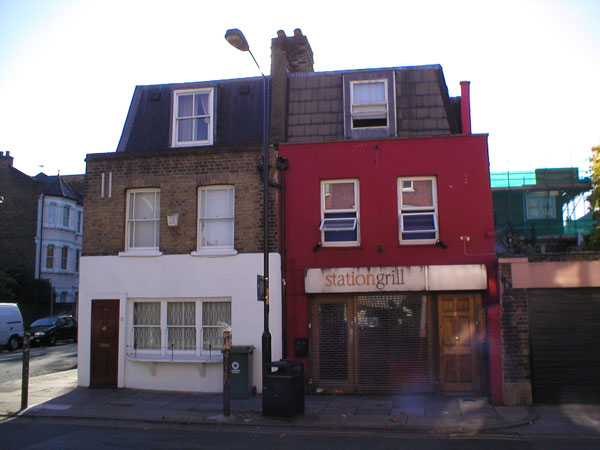 |
    
Stephen Thomas
Unregistered guest
| | Posted on Saturday, October 29, 2005 - 8:38 am: | 





|
This is Alberta Street London SE17, formerly Albert Street, where Thomas Cutbush lived at No.14. The house would have been towards the far end of the street on the left.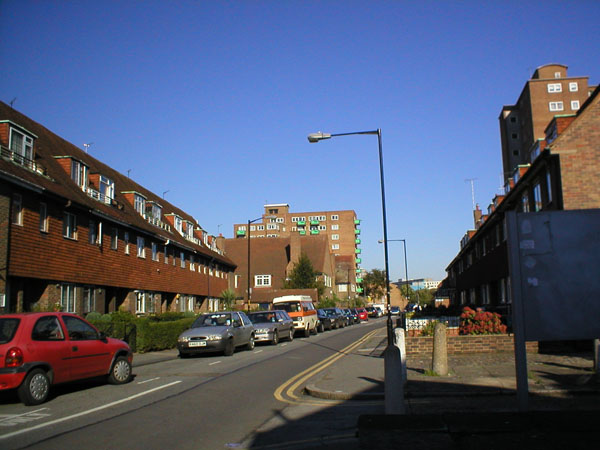 |
    
Stephen Thomas
Unregistered guest
| | Posted on Saturday, October 29, 2005 - 9:26 am: | 





|
Here is the corner of Alberta Street and Penton Place showing showing some 'dwellings' on Penton Place that would have been there in Thomas's time probably.
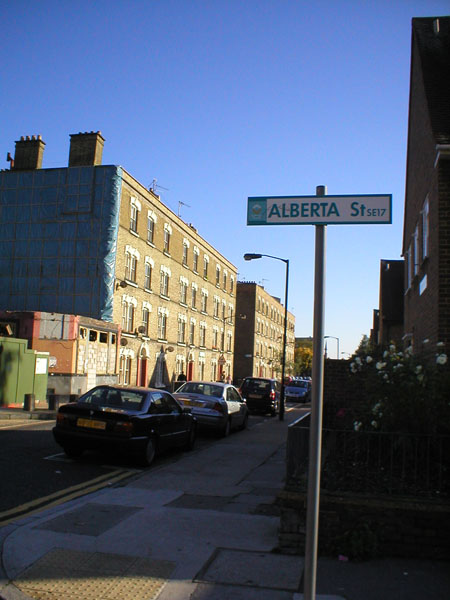 |
    
Natalie Severn
Assistant Commissioner
Username: Severn
Post Number: 2557
Registered: 11-2003
| | Posted on Wednesday, November 02, 2005 - 12:23 pm: | 





|
Hi Stephen,Many Thanks for these.
I wonder what the road looked like that Supt.Charles Cutbush lived in?Why,if he was in such a senior position was he not living in a grander house I wonder?His pension wasnt phenomenal-maybe he wasnt so well off then?
But anyway,what we are looking at is the old stomping ground of Messrs Colocott and Cutbush-both living within a short walk of each other[and of Supt Cutbush,]at Aldebert Terrace and Albert Street respectively.
Confusingly similar names,confusingly similar addresses
and the pair of them up before the beak for poking girls in the bottom with some sort of knife.
Since it was said at his trial that Colocott had possibly committed the same type of offence
up to 50 times and was actually CAUGHT IN THE ACT - it really does raise questions about whether Cutbush was confused with Colocott -deliberately or because their paths crossed especially as
Cutbush was accused of attacking only two girls
and neither girl appeared was sure it definitely was Cutbush.
How then did these two relatively minor offences, that Macnaghten reminded his colleagues were not at all in the same league as the Whitechapel 1888 murders, cause only Thomas Cutbush to be considered insane and unfit to plead and sent to Broadmoor?
Something is wrong somewhere!
Anyway,thanks again Stephen for showing us where they both lay their scent!
Natalie
It strikes me that any old opportunistic ploy was used to get Thomas Cutbush banged up for life in Broadmoor----especially as Colocott got off with just a fifty guinea fine-a guinea for every girl he managed to poke in the bottom by the sound of it----or was it 200 guineas-4 guineas a Job?
Unless ofcourse someone,somewhere knew Thomas actually was indeed a far more dangerous character! |
    
AP Wolf
Assistant Commissioner
Username: Apwolf
Post Number: 2760
Registered: 2-2003
| | Posted on Wednesday, November 02, 2005 - 1:43 pm: | 





|
Yes, thanks to Stephen for all his hard work here, which I feel a great contribution to our general understanding of the entire Cutbush fiasco.
Natalie, I have always believed that the Cutbush-Colicitt situation is one of the essential keys to solving the mystery of the Cutbush connection to the Whitechapel Murders, when not the entire case.
The disparity is sentencing has still not been explained, and there does appear to be a general confusion - then and now - regarding the two cases; a confusion shared by the police, courts and press.
I do know that some of the most impressive minds around here share your interest in these two very similar cases, and would also like some answers.
My understanding is that Colicitt was not even fined, his rich father had to come up with a �250 surety and employ a carer to watch over him, which he didn't, as Robert pointed out some time ago. |











